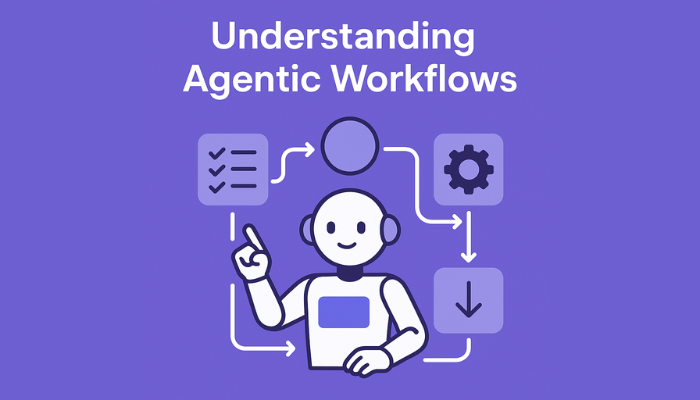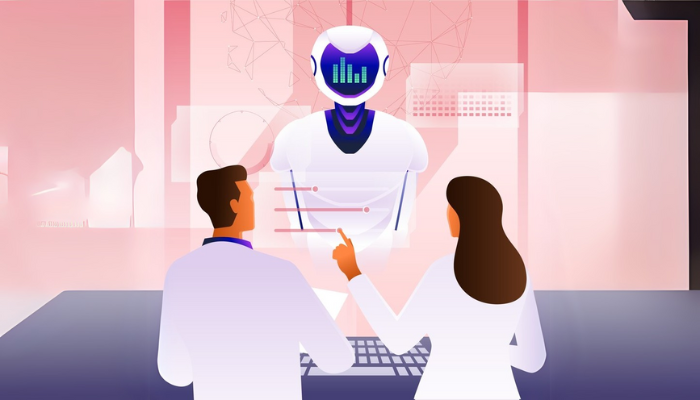AI agents. Agentic AI. Agentic architectures. Agentic workflows. These terms are everywhere, but do they actually mean anything? Can these agents really do something useful, or is it just all hype?
With new technology comes a flood of complex terminology, bold promises, and countless “experts” offering quick fixes. But, what exactly are AI agents, and why are they so crucial to the way businesses are automating and optimizing their operations?
To help you get there, we’ll go through the key components of AI agents, provide a concise definition of agentic workflows, explain what makes a workflow agentic, elaborate on the key recurring patterns in agentic workflows, showcase real-world examples and use cases, and offer an honest overview of the benefits and challenges of using agentic workflows.
What Are AI Agents?
You’ve probably heard the term AI agents floating around, but what do they really mean? Simply put, AI agents are systems that can perform tasks, make decisions, and adapt on their own, without needing you to step in every time. Imagine having a smart assistant that not only follows instructions but also learns from the environment and makes decisions based on that.
These agents can analyze data, recognize patterns, and act accordingly. For example, think of a chatbot on a website that can chat with customers, understand their questions, and offer solutions, all without waiting for someone to guide it. It learns over time, gets better at responding, and can even predict what a customer might need next.
However, it’s important to note that current AI agents are typically Narrow AI—designed to perform specific tasks within a limited scope. These agents are highly effective in their areas, like handling customer queries or automating repetitive tasks. However, they are not yet capable of full autonomous decision-making across all contexts. In contrast, General AI—the kind of AI that could perform any intellectual task a human can—remains a theoretical goal for the future.
But wait—knowing what AI agents are is just the start. To truly understand their power, we need to explore how they actually operate.
Components of AI Agents
So, what exactly makes an AI agent tick? At the heart of every AI agent are a few key components that allow it to function on its own. Let’s break them down:
1. Reasoning
Reasoning is a core component that distinguishes AI agents from simpler automation tools. It allows the agent to actively “think” through problems and adjust its approach during task execution. AI agents use reasoning for two primary functions: planning and reflection.
- Planning: In this phase, the agent breaks down complex problems into smaller, manageable steps. This task decomposition allows the agent to approach challenges systematically and use various tools for different stages. It also involves query decomposition, where complex queries are broken down into simpler ones for more accurate and reliable responses from the AI model.
- Reflection: After taking action, the agent reflects on the outcomes of its decisions. This self-assessment helps the agent adjust its actions based on feedback, improving its decision-making over time and adapting to new data.
2. Tools
AI agents extend their capabilities beyond static knowledge by using external tools. While large language models (LLMs) have parametric knowledge limited to the training data, tools enable AI agents to access real-time information and interact with external systems, applications, and databases.
Common tools for AI agents include:
- Internet Search: Retrieves and summarizes real-time information.
- Vector Search: Retrieves external data for further analysis.
- Code Interpreter: Executes and iterates on code generated by the agent itself.
- API: Connects to external services to retrieve information or perform tasks.
When an agent selects a tool, it engages in function calling, expanding its capabilities beyond just generating text and enabling real-world interactions. The choice of tools can be predetermined by the user or dynamically selected by the agent depending on the task complexity.
3. Memory
Memory is what allows AI agents to learn from past interactions and retain context over time. It is key to improving the agent’s performance and enabling personalized experiences. AI agents have two primary types of memory:
- Short-Term Memory: This type of memory holds immediate information, such as conversation history or the current context of a task. It helps the agent make decisions about the next steps in real time and ensures that short-term actions align with overall goals.
- Long-Term Memory: Over multiple interactions or sessions, long-term memory stores accumulated knowledge and experiences. This allows the agent to personalize its responses and improve its efficiency and accuracy over time. The more the agent learns, the better it performs, as it builds a rich dataset of prior interactions.
These three core components—reasoning, tools, and memory—work together to give AI agents the ability to perform tasks autonomously, adapt to new conditions, and improve their effectiveness over time.
Now that we’ve got the basics down, let’s talk about how agentic workflows make all this possible and how they help AI agents actually get things done.
What Are Agentic Workflows?
Agentic workflows are the processes that guide AI agents in performing tasks and achieving goals autonomously. Unlike traditional workflows, which require human input or strict instructions, agentic workflows allow agents to make decisions, adapt to new information, and act independently. These workflows help AI agents complete tasks efficiently without constant supervision.
For example: An eCommerce AI agent can automatically process orders, check stock levels, and even restock items based on demand, all within a defined workflow.
What Makes a Workflow Agentic?
A workflow becomes agentic when it allows an AI agent to operate with autonomy, adaptability, and continuous improvement. Here’s what that means:
- Autonomy: The AI agent doesn’t need constant human intervention. It can make decisions based on the data it receives and act accordingly. For example, if an agent is managing inventory, it doesn’t need someone to manually approve when to reorder stock—it can make that decision by analyzing current inventory levels and sales trends on its own.
- Adaptability: The workflow allows the agent to change its actions based on new information. For instance, if a customer service agent encounters a problem it hasn’t seen before, it can adjust its response strategy based on past interactions, new data, or changes in customer behavior. The workflow gives it the flexibility to react differently based on the situation at hand.
- Learning from Experience: Agentic workflows enable the agent to learn from its actions over time. This could involve improving the decision-making process by evaluating previous outcomes and adjusting for better results. For example, if an AI agent handling appointments notices that certain timeslots get booked more frequently, it can adjust its scheduling pattern to prioritize those slots, improving efficiency in the future.
To fully understand agentic workflows, it’s important to first distinguish them from agentic architectures. While both are critical to an AI agent’s function, they play different roles in the system.
The Difference Between Agentic Architectures and Workflows
While agentic architectures and agentic workflows are closely related, they serve different functions in the AI system.
Imagine you’re building an AI agent to manage customer service interactions. The workflow will lay out the steps the agent follows to assist the customer—like greeting, asking questions, offering solutions, and following up.
However, for the agent to decide the best course of action, it needs a structure or architecture that allows it to understand customer inputs, learn from past interactions, and adjust its responses accordingly. This is where agentic architecture comes in.
| Aspect | Agentic Architecture | Agentic Workflows |
| Definition | The internal framework that enables the agent to process data, make decisions, and learn. | The specific sequence of tasks and steps that the agent follows to accomplish a goal. |
| Primary Function | Allows the agent to “think,” learn, and make decisions based on data and past experiences. | Provides a structured path for the agent to complete tasks, such as responding to a query or processing an order. |
| Components | Includes decision-making algorithms, data processing units, and learning models. | Includes task decomposition, process sequencing, and feedback loops for adjusting the agent’s actions. |
| Role in AI Agent | Acts as the foundational infrastructure for the agent’s capabilities. | Guides the agent through specific tasks by defining the steps needed to achieve the goal. |
| Flexibility | Provides the ability to adapt and make decisions in varying contexts, enabling the agent to work across different tasks. | Follows a pre-defined path that’s customized for specific tasks, making it more rigid in comparison. |
| Adaptability | Can adapt to new situations based on learning, making decisions autonomously over time. | Adaptability is limited to the specific workflows set by the task design; changes require updates to the workflow. |
| Example | Decision-making algorithms that determine how an agent should respond based on inputs (e.g., NLP models). | A structured workflow for processing a customer order, including steps like validating payment, inventory check, and shipment. |
| Optimization | Continuously optimizes the agent’s decision-making process through learning and data analysis. | Optimized for task efficiency but may require manual updates to improve process flows. |
Patterns in Agentic Workflows
When we talk about agentic workflows, several recurring patterns emerge that guide AI agents in performing their tasks, these patterns help structure the agent’s decision-making and ensure the workflow runs smoothly.
Just like any well-designed system, certain approaches are consistently applied in how an agent tackles a task. Here are some common patterns in agentic workflows:
- Planning Pattern: This pattern involves the AI agent setting a goal and then planning the steps to achieve it. It’s similar to making a list of actions before starting a project. The agent assesses the task, organizes the steps, and decides the most efficient way to accomplish the goal.
- Tool Use Pattern: In many cases, agents need external tools or resources to complete tasks. This pattern enables the agent to interact with databases, APIs, or other software systems to gather information or execute actions. For example, an AI agent in a healthcare app might use this pattern to retrieve patient records or lab results from an external system.
- Reflection Pattern: After completing a task, the agent evaluates its actions and outcomes. This pattern involves reflecting on what worked, what didn’t, and adjusting its approach for future tasks. By learning from past experiences, the agent becomes more effective over time.
So, now that we understand the key patterns that make agentic workflows effective, let’s explore some real-world use cases to see how these workflows are being implemented in various industries. From customer service automation to healthcare, agentic workflows are already making a significant impact.
Use Cases of Agentic Workflows
Let’s get to the practical stuff—how they’re actually being used in the real world. While a lot of people talk about AI agents in general terms, let’s get into some use cases that are often overlooked but are making a huge impact across industries.
Agentic RAG (Reasoning, Action, and Goals)
This might sound like something out of a sci-fi movie, but RAG is actually being used to automate decision-making in industries like healthcare and finance. Imagine an AI agent in a hospital that not only monitors a patient’s vital signs but also makes real-time decisions about treatment adjustments based on that data.
It sets a goal, figures out what actions to take, and adapts if the conditions change—without any human intervention. The agent is constantly learning and evolving its decision-making process based on past outcomes.
Agentic Research Assistants
Ever wish you had an assistant who could read hundreds of research papers and summarize them for you? Well, that’s already happening! In fields like medical research or academia, AI agents are handling the legwork.
These agents can sift through vast amounts of data, pull out key insights, and even suggest the next steps in research. They follow agentic workflows to handle repetitive tasks (like data extraction and literature review) and learn from each task, improving their efficiency with every new project.
Agentic Coding Assistants
If you’ve ever had to debug code or figure out why something’s not working, you know how frustrating it can be. Enter agentic coding assistants. These AI agents can not only suggest code snippets but can also debug and write entire functions, all based on previous patterns and learned behavior.
These agents follow a workflow that helps them get smarter with every line of code they analyze, saving developers tons of time by automating repetitive coding tasks.
Customer Support Automation
It’s no secret that AI is revolutionizing customer service, but how many people realize that AI agents are taking over entire customer support workflows? Imagine an AI agent that can handle customer inquiries, process support tickets, and even escalate issues when needed—all without human oversight.
The real magic happens when these agents follow agentic workflows: they not only respond based on pre-programmed rules but also adjust to customer sentiment and past interactions, making every conversation feel personal and efficient.
Supply Chain Optimization
Here’s something not many people cover—how AI agents are improving supply chain management. With agentic workflows, AI agents can predict demand, monitor inventory levels, and even make automatic reordering decisions.
They adjust the workflow in real time based on new data, like shifts in demand or delays in shipment, ensuring smooth operations. This level of autonomy is what helps businesses stay ahead in industries that depend on tight supply chain management.
Personalized Learning Paths
AI agents are being used to create individualized learning paths for students based on their strengths, weaknesses, and learning preferences. These agents can track progress, suggest customized resources, and adapt the learning journey as students advance, ensuring that each student receives the most effective and relevant content.
Automated Financial Risk Assessment
AI agents are being used to assess financial risk in real time. These agents analyze credit histories, transaction data, and market trends to predict potential risks, like loan defaults or investment volatility. With this data, AI agents can automate risk assessments, enabling quicker and more accurate decision-making in financial services.
AI-Driven Fraud Detection
In the financial sector, AI agents are trained to detect unusual patterns in transactions, flagging potential fraudulent activities. These agents continuously analyze vast amounts of transaction data, learning from past fraud cases, and making real-time decisions on whether to approve or decline transactions—minimizing the risk of fraud with each transaction processed.
AI Agents Built for Your Industry
Let’s take a closer look at some specific examples of how agentic workflows are being applied to solve real problems across various industries.
Examples of Agentic Workflow Applications
Claygent (Clay): One standout example of agentic workflows in action is Claygent, an AI assistant that automates everyday administrative tasks. By following agentic workflows, Clay can manage your calendar, schedule meetings, send reminders, and organize tasks—all without constant supervision. The workflow adapts over time, learning from user preferences to ensure maximum efficiency and a personalized experience.
ServiceNow AI Agents: In the world of IT service management, ServiceNow has integrated agentic workflows to automate incident management. Their AI agents use these workflows to quickly resolve issues, assign tickets, and escalate complex problems when needed. These agents don’t just follow predefined rules; they adapt based on the urgency of issues, historical data, and SLA requirements, ensuring a more dynamic and responsive service.
Also Read: Step-by-Step Guide on Building AI Agents for Beginners
Benefits of Agentic Workflows
Now that we’ve explored how agentic workflows are being implemented, let’s get to the heart of the matter: Why should you care about them? What makes agentic workflows a game-changer for businesses, and why are they much more than just a buzzword?
. Here’s why they stand out:
- Hyper-Efficiency with Smarter Automation: Many systems promise automation, but agentic workflows elevate it. It’s not just about automating tasks; it’s about doing it faster and smarter. AI agents continuously refine their processes, learning from past interactions and adjusting their workflows in real-time.
This means faster decisions, quicker problem-solving, and significant time savings. Imagine an AI agent handling thousands of customer queries at once, learning from each one to make future interactions smoother—no human needed.
- Reliability That Doesn’t Waver: In a world where consistency matters, agentic workflows deliver just that. Unlike human-driven processes, these workflows are designed to handle the same task flawlessly every time, without getting distracted or tired.
If you’re running a healthcare system where the smallest error could cost a lot, the consistency provided by agentic workflows in areas like patient data handling or billing is invaluable. The workflow remains the same, regardless of time or workload.
- Scalability That Grows With You: The future of business is scalability. What sets agentic workflows apart is their ability to grow seamlessly with your business without the need for extra hands.
Whether you’re scaling your eCommerce operations or expanding into new markets, AI agents following agentic workflows can adjust to increased demands without requiring additional human resources. When inventory levels change or customer queries increase, the AI agent adapts automatically, streamlining operations and cutting costs.
- Informed Decisions That Evolve Over Time: In many traditional systems, decision-making is static. With agentic workflows, decisions evolve as the agent gathers more information. These workflows continuously adapt to new data, which means your AI agent is making smarter, more informed decisions every time.
Think of it as an AI that improves every time it interacts with customers, optimizing itself for better results. In industries like finance or healthcare, this type of adaptability can mean the difference between success and failure.
- Real Cost Savings, Not Just Automation: Automation isn’t just about replacing human labor—it’s about making operations more efficient and cutting costs. While traditional workflows may require constant monitoring and adjustments, agentic workflows remove the need for constant oversight.
With AI agents handling tasks like inventory management, customer support, or administrative functions, businesses see real savings in time and resources. The result? More efficiency at a lower operational cost.
- Agility in a Rapidly Changing World: The true value of agentic workflows lies in their ability to adapt. The world changes fast, and businesses need to keep up. AI agents with agentic workflows are not only capable of learning from past experiences, but they also adjust their actions in response to new data and challenges. If demand shifts unexpectedly or customer behavior changes, the agent can revise its workflow in real time to stay on course, ensuring your business remains agile and competitive.
You might also like: Building Agentic AI Framework: Architecture & Key Components.
While agentic workflows offer significant benefits, they’re not without their challenges. As with any advanced technology, there are some hurdles to overcome before realizing their full potential. Let’s take a look at the limitations that come with agentic workflows and why they’re worth considering as you plan for the future.
Challenges and Limitations of Agentic AI Workflows
While agentic workflows are powerful, they are not without their challenges. Implementing these workflows requires a deep understanding of both the technology and the real-world problems it’s solving. Here are some key limitations to keep in mind:
- Complexity in Design and Implementation: Creating effective agentic workflows is not a simple task. It requires careful planning, clear objectives, and a robust system architecture. Since these workflows allow AI agents to make autonomous decisions, the risk of mistakes increases if the underlying design isn’t foolproof. A poorly designed workflow can lead to unexpected behaviors, which can be costly, especially in industries like healthcare or finance where mistakes are critical.
- Data Dependency: Agentic workflows thrive on data, and the quality of the data directly impacts the performance of the AI agents. If the data fed into these workflows is incomplete, outdated, or biased, it can lead to inaccurate decision-making.
For example, in predictive analytics for supply chain management, poor data quality can cause the AI agent to make faulty predictions, leading to stock shortages or excess inventory.
- Limited Flexibility in Unpredictable Scenarios: While agentic workflows are designed to adapt based on changing information, they can still struggle in completely new or unpredictable situations. If an AI agent encounters a scenario it hasn’t been trained on or doesn’t have the necessary data to adjust, it might fail to take appropriate action or make the wrong decision. This is a key challenge, especially in dynamic environments where the unexpected is the norm.
- Integration with Legacy Systems: Many businesses still rely on legacy systems that may not be fully compatible with newer AI technologies. Integrating agentic workflows with older infrastructure can be a complex and time-consuming process.
Ensuring that AI agents can seamlessly interact with these systems without disrupting operations is a challenge that requires technical expertise and careful system design.
- Ethical and Accountability Issues: As AI agents become more autonomous, questions around ethics and accountability arise. Who is responsible if an AI agent makes a harmful decision or causes an error? Ensuring that these workflows are transparent and ethically sound is crucial, especially in sensitive industries like healthcare or finance, where decisions can have far-reaching consequences.
- High Initial Investment: Setting up agentic workflows involves a significant initial investment in technology, infrastructure, and talent. For smaller businesses or those new to AI, the upfront costs can be daunting. However, the long-term benefits of scalability, efficiency, and autonomy often outweigh these initial costs.
Despite these challenges, the potential of agentic workflows is undeniable. By recognizing the limitations and addressing them strategically, businesses can apply the full power of AI agents to drive smarter, more efficient operations.
How Codewave Helps in AI Agent Development
At Codewave, we specialize in developing AI solutions that enable businesses to automate tasks, enhance decision-making, and drive efficiency. Our team integrates Next-gen AI technologies into workflows, helping you use the true potential of intelligent agents. We focus on building adaptive AI agents that can work autonomously, learn from experience, and optimize their actions over time.
Here’s how we can help with AI agent development:
- Custom AI Agent Development: We design and develop AI agents customized to your specific needs, from automating customer service to enhancing operational workflows. Using technologies like TensorFlow and PyTorch, we ensure that the AI agents not only perform tasks but continuously improve and adapt to new challenges.
- Agentic Workflow Design & Integration: Our team helps you create intelligent workflows that allow your AI agents to follow processes autonomously. These workflows are powered by machine learning algorithms and decision trees, ensuring that agents make informed decisions in real-time, all while integrating seamlessly with existing systems like CRM, ERP, and EHR through REST APIs and GraphQL.
- Advanced Data Analytics & Machine Learning: We incorporate powerful machine learning models and data analytics into agentic workflows to ensure that your AI agents are not just following instructions, but learning from data and improving over time. We use tools like Google BigQuery and AWS SageMaker to process and analyze vast amounts of data, making smarter decisions and predictions.
To give you a better idea of our capabilities, we specialize in AI/ML solutions that create real-world value. One of our standout projects is Alexis – The AI-Powered Travel Assistant, an intelligent travel assistant app we built for a seamless, personalized travel experience.
How We Applied AI/ML to Build Alexis
- Personalized Recommendations: Alexis uses machine learning algorithms to understand user preferences and offer tailored travel suggestions in real-time, whether it’s booking flights, hotels, or local experiences.
- Voice and Text Recognition: The app uses advanced AI to understand voice and text inputs, refining suggestions based on user interactions.
- Proactive Decision-Making: Alexis adapts by learning from previous interactions, improving its decision-making and providing more accurate, relevant suggestions with every use. For a detailed look at how we applied AI/ML in this project, check out the full case study on Alexis – AI-Powered Travel Assistant.
- Real-Time Decision-Making: With AI-driven decision support systems, we build solutions that enable AI agents to make real-time decisions based on dynamic inputs. We use TensorFlow for deep learning and scikit-learn for faster, more efficient model training, ensuring the AI system responds quickly to changing conditions in your business.
- Scalability & Cloud Integration: As your business grows, so should your AI system. We use cloud services like AWS, Google Cloud, and Microsoft Azure to ensure that your AI agents and workflows are scalable and can handle increasing workloads without compromising performance.
- Continuous Monitoring & Improvement: We don’t stop at deployment. Codewave offers ongoing monitoring, retraining, and optimization services to ensure that your AI agents stay effective and continue to evolve. We use Prometheus and Grafana for real-time monitoring, ensuring that your workflows remain responsive and efficient.
With Codewave, you get more than just an AI solution. You get a partner who understands the latest trends in AI development and works closely with you to build a scalable, adaptable, and powerful AI-driven system.
AI agents that adapt and grow.
Codewave is a UX first design thinking & digital transformation services company, designing & engineering innovative mobile apps, cloud, & edge solutions.







